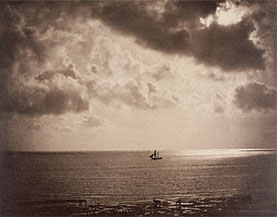|
At the beginning of the 1840s Le Gray studied painting with Paul Delaroche, first at his studio in Paris and then in Rome, where they both relocated.
Le Grays closest friend, Henri Le Secq, another painter who would become a photographer, also moved there. While in Rome, Le Gray began to study the chemistry of the principal methods of the new medium of photography—the daguerreotype process and various paper negative processes.
Problems with earlier paper negative techniques led Le Gray to perfect the waxed paper process in 1849. The fibers of a paper negative interfered with its transparency and resolution of detail, and the fiber texture showed through in prints. Le Grays technique of waxing the negative before use produced a smoother and clearer result. This process became popular among French photographers in the mid-1840s.
A studio Le Gray set up on the outskirts of Paris in 1849 became a center for his experiments, for teaching photography to his friends and well-heeled amateurs, and for making portraits of his numerous visitors.
In 1855, Le Gray moved to an expensively equipped portrait studio in central Paris. The style and oval shape of his self-portrait is the same as those that the portrait studio provided for his clients.
Later, for his images of sea and military maneuvers, Le Gray shifted from the softness of his salt prints made from paper negatives to the clarity of albumen prints made from wet collodion on glass negatives.
Collodion as a negative was overly sensitive to blue light. If a negative was exposed long enough to obtain detail in the foreground, the sky was overexposed and printed white. Le Grays solution was to make his seascapes from two negatives, printed together to give definition to both sea or shoreline below and the sky with clouds above. The resulting image is often referred to as a combination print.
However, in what would become Le Grays most famous seascape—The Brig, pictured here—the equal luminosity of sea and sky required only a single negative. Hundreds of prints of this image were sold in France, England, and Scotland.
|
 |
 |
 |
 |
 |
 |
 |
 |
 |
 |
|
 |
 |
 |
Albumen print |
 |
 |
Photographic process invented in 1850 by Louis-Désiré Blanquart-Evrard, prevalent until 1890. After floating on a bath of albumen (egg whites) and salt, the paper was coated with silver nitrate solution, dried, and placed directly under a negative for printing.
|
 |
 |
 |
Combination print |
 |
 |
The combination of two or more negatives to produce one photographic print. Particularly popular during the 1860s to add cloud-filled skies to landscapes, it involved selectively masking sections of the print while printing from each negative.
|
 |
 |
 
|
|
 |
 |
 |
Daguerreotype |
 |
 |
A one-of-a-kind, positive, small-scale image formed on a silver-plated copper sheet made sensitive to light by iodine vapors. Named for its inventor Louis-Jacques Mandé Daguerre, it was popular for portraits and was kept in a case under glass to avoid scratching.
|
 |
 |
 |
Salt print |
 |
 |
The earliest positive prints, printed in daylight directly under a calotype negative onto paper previously immersed in salt (sodium chloride) solution and coated with silver nitrate to produce light-sensitive silver chloride. Most were made from 1840 to 1860.
|
 |
 |
 |
Wet collodion |
 |
 |
A sticky solution of guncotton, alcohol, ether, and potassium iodide was evenly poured over a glass plate. This negative was then bathed in silver nitrate solution, producing light-sensitive silver iodide. The plates, common from 1850 to 1880, were used while still damp.
|
 |
 |
 |
Wet collodion process |
 |
 |
Invented in 1851, the wet collodion photographic process produced a glass negative from which a beautifully detailed print could be made. Preferred for the quality of the prints and the number of prints that could be made from them, this method thrived from the 1850s until about 1880.
|
 |
 |
 
|
|
 |
 |
 |
|
 |

